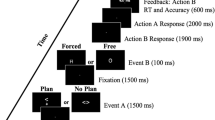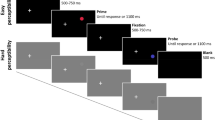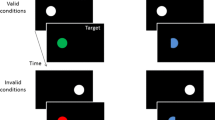Abstract
Often one must depart from an intended course of events to react to sudden situational demands before resuming his or her original action retained in working memory. Retaining an action plan in working memory (WM) can delay or facilitate the execution of an intervening action when the action features of the two action plans partly overlap (partial repetition) compared to when they do not overlap. We investigated whether partial repetition costs (PRCs) or benefits (PRBs) occur when the intervening event is an ideomotor-compatible stimulus that is a biological representation of the response required by the participant. Participants viewed two visual events and retained an action plan to the first event (A) while executing a speeded response to the second, intervening event (B). In Experiment 1A, the two visual events were ideomotor compatible, non-ideomotor compatible (abstract), or one was ideomotor compatible, and the other abstract. Results showed PRCs for all event A–B stimulus combinations with reduced PRCs for intervening, ideomotor compatible events. In contrast to previous research, there was no evidence that ideomotor-compatible actions were automatic and bypassed the selection bottleneck. Experiment 1B confirmed PRCs for ideomotor compatible stimuli that more accurately mimicked the required response. Findings suggest that mechanisms for activating, selecting, and retaining action plans are similar between ideomotor compatible and abstract visual events. We conclude that PRCs occur in response to intervening events when action plans are generated offline and rely on WM, including those for ideomotor-compatible stimuli; but PRBs may be restricted to actions generated online. This conclusion is consistent with the perceptual-motor framework by Goodale and Milner (Trends in Neuroscience 15:22–25, 1992).





Similar content being viewed by others
Supporting Data for the Current Project
This can be accessed at: https://research.libraries.wsu.edu/xmlui/handle/2376/17908.
Notes
Responses were only defined by execution of the second keypress response in Experiment 1A, and hence RT for the first keypress was not available. However, the first and second keypress RTs were recorded and are reported in Experiment 1B.
Assessing response accuracy to event A was necessary to ensure participants retained the action plan to the first event in memory while executing their response to the interruption (event B). The response accuracy results for event A have to be interpreted with caution as participant inclusion required that they achieve 80% accuracy. Also, we did not analyze RT for event A for two reasons. First, we asked participants to take their time to respond to event A in order to respond as accurately as possible. They were also told that we were not concerned with how fast they responded to event A, only how accurate they responded. Second, RT for event A was confounded with responses executed to event B. That is, when there was action overlap (i.e., responses to events A and B shared the same response hand), the motor response for event A had to wait for the response to event B to finish before it could start; but when there was no action overlap, the motor response for event A did not necessarily have to wait for the motor response to event B to finish before it could start.
Similar to Experiment 1A, RTs to the second key press are shown. RTs to the first keypress were 161–171 ms faster than the second keypress for all three conditions. RTs to the first keypress were 646 ms, 690 ms, and 718 ms for the no retention, no overlap, and partial overlap conditions respectively.
References
Barber, P., & O’Leary, M. (1997). The relevance of salience: towards an activational account of irrelevant stimulus-response compatibility effects. Advances in Psychology, 118, 135–172. https://doi.org/10.1016/S0166-4115(97)80031-3.
Behmer, L. P., & Fournier, L. R. (2014). Working memory modulates neural efficiency over motor components during a novel action planning task: An EEG study. Behavioural Brain Research, 260, 1–7. https://doi.org/10.1016/j.bbr.2013.11.031.
Behmer, L. P., & Fournier, L. R. (2016). Mirror neuron activation as a function of explicit learning: changes in mu-event-related power after learning novel responses to ideomotor compatible, partially compatible, and non-compatible stimuli. European Journal of Neuroscience, 44(10), 2774–2785. https://doi.org/10.1111/ejn.13389.
Brass, M., Bekkering, H., & Prinz, W. (2001). Movement observation affects movement execution in a simple response task. Acta Psychologica, 106(1), 3–22. https://doi.org/10.1016/S0001-6918(00)00024-X.
Brass, M., Bekkering, H., Wohlschläger, A., & Prinz, W. (2000). Compatibility between observed and executed finger movements: comparing symbolic, spatial, and imitative cues. Brain and Cognition, 44, 124–143. https://doi.org/10.1006/brcg.2000.1225.
Braver, T. S. (2012). The variable nature of cognitive control: a dual mechanisms framework. Trends in Cognitive Science, 16(2), 106–113. https://doi.org/10.1016/j.tics.2011.12.010.
Braver, T. S., Reynolds, J. R., & Donaldson, D. I. (2003). Neural mechanisms of transients and sustained cognitive control during task switching. Neuron, 39, 713–726. https://doi.org/10.1016/S0896-6273(03)00466-5.
Cattaneo, L., Caruana, F., Jezzini, A., & Rizzolatti, G. (2009). Representation of goal and movements without overt motor behavior in the human motor cortex: a transcranial magnetic stimulation study. The Journal of Neuroscience, 29(36), 11134–11138. https://doi.org/10.1523/JNEUROSCI.2605-09.2009.
Chiavarino, C., Bugiani, S., Grandi, E., & Colle, L. (2013). Is automatic imitation based on goal coding or movement coding? A comparison of goal-directed and goal-less actions. Experimental Psychology, 60(3), 213–225. https://doi.org/10.1027/1618-3169/a000190.
Cracco, E., Bardi, L., Desmet, C., Genschow, O., Rigoni, D., De Coster, L., et al. (2018). Automatic imitation: a meta-analysis. Psychological Bulletin, 144(5), 453–500. https://doi.org/10.1037/bul0000143.
Eimer, M., Hommel, B., & Prinz, W. (1995). SR compatibility and response selection. Acta Psychologica, 90(1), 301–313. https://doi.org/10.1016/0001-6918(95)00022-M.
Faul, F., Erdfelder, E., Buchner, A., & Lang, A. G. (2009). Statistical power analyses using G* Power 3.1: tests for correlation and regression analyses. Behavior Research Methods, 41(4), 1149–1160. https://doi.org/10.3758/BRM.41.4.1149.
Fournier, L. R., Behmer, L. P., Jr., & Stubblefield, A. M. (2014a). Interference due to shared features between action plans is influenced by working memory span. Psychonomic Bulletin and Review, 21, 1524–1529. https://doi.org/10.3758/s13423-014-0627-0.
Fournier, L. R., Gallimore, J. M., Feiszli, K. R., & Logan, G. D. (2014b). On the importance of being first: serial order effects in the interaction between action plans and ongoing actions. Psychonomic Bulletin and Review, 21(1), 163–169. https://doi.org/10.3758/s13423-013-0486-0.
Fournier, L. R., Hansen, D. A., Stubblefield, & Van Dongen, H. (2020). Action plan interrupted: resolution of proactive interference while coordinating execution of multiple action plans during sleep deprivation. Psychological Research Psychologische Forschung, 84, 454–467. https://doi.org/10.1007/s00426-018-1054-z.
Fournier, L. R., Wiediger, M. D., McMeans, R., Mattson, P. S., Kirkwood, J., & Herzog, T. (2010). Holding a manual response sequence in memory can disrupt vocal responses that share semantic features with the manual response. Psychological Research Psychologische Forschung, 74, 359–369. https://doi.org/10.1007/s00426-009-0256-9.
Fournier, L. R., Wiediger, M. D., & Taddese, E. F. (2015). Action plans can interact to hinder or facilitate reach performance. Attention, Perception, and Psychophysics, 77, 2755–2767. https://doi.org/10.3758/s13414-015-0959-5.
Glover, G. H. (1999). Deconvolution of impulse response in event-related BOLD fMRI. Neuroimage, 9(4), 416–429.
Glover, S. (2002). Visual illusions affect planning but not control. Trends in Cognitive Sciences, 6(7), 288–292. https://doi.org/10.1016/S1364-6613(02)01920-4.
Glover, S. (2004). Planning and control in action. Behavioral and Brain Sciences, 27(1), 57–69. https://doi.org/10.1017/S0140525X04520022.
Glover, S., Wall, M. B., & Smith, A. T. (2012). Distinct cortical networks support the planning and online control of reaching-to-grasp in humans. European Journal of Neuroscience, 35(6), 909–915. https://doi.org/10.1111/j.1460-9568.2012.08018.x.
Gonzalez, C., Ganel, T., & Goodale, M. (2006). Hemispheric specialization for the visual control of action is independent of handedness. Journal of Neurophysiology, 95, 3496–3501. https://doi.org/10.1152/jn.01187.2005.
Goodale, M. A. (2016). How (and why) the visual control of action differs from visual perception. Proceedings of the Royal Society, 281, 1–9. https://doi.org/10.1098/rspb.2014.0337.
Goodale, M. A., & Humphrey, G. K. (1998). The objects of action and perception. Cognition, 67, 179–205. https://doi.org/10.1016/S0010-0277(98)00017-1.
Goodale, M. A., & Milner, A. D. (1992). Separate visual pathways for perception and action. Trends in Neuroscience, 15, 22–25. https://doi.org/10.1016/0166-2236(92)90344-8.
Greenwald, A. G. (1970). Sensory feedback mechanisms in performance control: with special reference to the ideo-motor mechanism. Psychological Review, 77(2), 73–99. https://doi.org/10.1037/h0028689.
Greenwald, A. G. (1972). On doing two things at once: Time sharing as a function of ideomotor compatibility. Journal of Experimental Psychology, 94, 52–57.
Greenwald, A. G. (2003). On doing two things at once: III. Confirmation of perfect timesharing when simultaneous tasks are ideomotor compatible. Journal of Experimental Psychology: Human Perception and Performance, 29(5), 859–868. https://doi.org/10.1037/0096-1523.29.5.859.
Greenwald, A. G., & Shulman, H. G. (1973). On doing two things at once: II. Elimination of the psychological refractory period effect. Journal of Experimental Psychology, 101(1), 70–76. https://doi.org/10.1037/h0035451.
Halvorson, K. M., Ebner, H., & Hazeltine, E. (2013). Investigating perfect timesharing: The relationship between IM-compatible tasks and dualtask performance. Journal of Experimental Psychology: Human Perception and Performance, 39, 413–432. https://doi.org/10.1037/a0029475.
Heyes, C. (2010). Where do mirror neurons come from? Neuroscience and Biobehavioral Reviews, 34(4), 575–583.
Heyes, C. (2011). Automatic imitation. Psychological Bulletin, 137, 463–483. https://doi.org/10.1037/a0022288.
Hommel, B. (2003). Planning and representing intentional action. The Scientific World Journal, 3, 593–608. https://doi.org/10.1100/tsw.2003.46.
Hommel, B. (2004). Event files: feature binding in and across perception and action. Trends in Cognitive Sciences, 8, 494–500. https://doi.org/10.1016/j.tics.2004.08.007.
Hommel, B. (2005). How much attention does an event file need? Journal of Experimental Psychology: Human Perception and Performance, 31, 1067–1082. https://doi.org/10.1037/0096-1523.31.5.1067.
Hommel, B. (2009). Action control according to TEC (theory of event coding). Psychological Research Psychologische Forschung, 73(4), 512–526. https://doi.org/10.1007/s00426-009-0234-2.
Hommel, B. (2019). Theory of Event Coding (TEC) V2.0: representing and controlling perception and action. Attention, Perception and Psychophysics, 81, 2139–2154. https://doi.org/10.3758/s13414-019-01779-4.
Hommel, B., Müsseler, J., Aschersleben, G., & Prinz, W. (2001). The theory of event coding (TEC): a framework for perception and action planning. Behavioural Brain Science, 24, 849–878. https://doi.org/10.1017/S0140525X01000103.
Janczyk, M., Pfister, R., & Kunde, W. (2012). On the persistence of tool-based compatibility effects. Journal of Psychology, 220, 16–22. https://doi.org/10.1027/2151-2604/a000086.
Kornblum, S., Hasbroucq, T., & Osman, A. (1990). Dimensional overlap: cognitive basis for stimulus-response compatibility—a model and taxonomy. Psychological Review, 97(2), 253–270. https://doi.org/10.1037/0033-295X.97.2.253.
Landmann, C., Landi, S. M., Grafton, S. T., & Della-Maggiore, V. (2011). fMRI supports the sensorimotor theory of motor resonance. PLoS ONE, 6(11), e26859. https://doi.org/10.1371/journal.pone.0026859.
Lien, M. C., McCann, R. S., Ruthruff, E., & Proctor, R. W. (2005). Confirming and disconfirming theories about ideomotor compatibility in dual-task performance: a reply to Greenwald (2005). Journal of Experimental Psychology: Human Perception and Performance, 31(1), 226–229. https://doi.org/10.1037/0096-1523.31.1.226.
Lien, M. C., Proctor, R. W., & Allen, P. A. (2002). Ideomotor compatibility in the psychological refractory period effect: 29 years of oversimplification. Journal of Experimental Psychology: Human Perception and Performance, 28(2), 396–409. https://doi.org/10.1037/0096-1523.28.2.396.
Maquestiaux, F., Ruthruf, E., Defer, A., & Ibrahime, S. (2018). Dualtask automatization: the key role of sensory-motor modality compatibility. Attention, Perception, and Psychophysics, 80(3), 752–772. https://doi.org/10.3758/s13414-017-1469-4.
Massen, C., & Prinz, W. (2009). Movements, actions and tool-use actions: an ideomotor approach to imitation. Philosophical Transactions of the Royal Society of London B: Biological Sciences, 364(1528), 2349–2358. https://doi.org/10.1098/rstb.2009.0059.
Masson, M. E., & Loftus, G. R. (2003). Using confidence intervals for graphically based data interpretation. Canadian Journal of Experimental Psychology, 57(3), 203–220. https://doi.org/10.1037/h0087426.
Mattson, P. S., Fournier, L. R., & Behmer, L. P., Jr. (2012). Frequency of the first feature in action sequences influences feature binding. Attention, Perception, and Psychophysics, 74, 1446–1460. https://doi.org/10.3758/s13414-012-0335-7.
Passingham, R. E., & Toni, I. (2001). Contrasting the dorsal and ventral visual systems: guidance of movement versus decision making. Neuroimage, 14, S125–S131. https://doi.org/10.1006/nimg.2001.0836.
Passingham, R. E., Toni, I., & Rushworth, M. F. S. (2000). Specialization within the prefrontal cortex: the ventral prefrontal cortex and associative learning. Experimental Brain Research, 133, 103–113. https://doi.org/10.1007/s002210000405.
Pfister, R., Dignath, D., Hommel, B., & Kunde, W. (2013). It takes two to imitate anticipation and imitation in social interaction. Psychological Science, 24(10), 2117–2121. https://doi.org/10.1177/0956797613489139.
Press, C., Catmur, C., Cook, R., Widmann, H., Heyes, C., & Bird, G. (2012). fMRI evidence of ‘mirror’ responses to geometric shapes. PLoS ONE, 7(12), e51934. https://doi.org/10.1371/journal.pone.0051934.
Prinz, W. (1997). Perception and action planning. European Journal of Cognitive Psychology, 9(2), 129–154. https://doi.org/10.1080/713752551.
Proctor, R.W., & Vu, K-P.L. (2006). Stimulus-Response Compatibility Principles: Data, Theory, and Application. CRC Press
Proctor, R. W., & Vu, K.-P.L. (2016). Principles for designing interfaces compatible with human information processing. International Journal of Human-Computer Interaction, 32(1), 2–22. https://doi.org/10.1080/10447318.2016.1105009.
Richardson, B., Pfister, R., & Fournier, L. R. (2020). Free-choice and forced-choice actions: shared representations and conservation of cognitive effort. Attention, Perception, and Psychophysics. https://doi.org/10.3757/s13414-020-01986-4.
Rizzolatti, G., Fogassi, L., & Gallese, V. (2001). Neurophysiological mechanisms underlying the understanding and imitation of action. Nature Reviews Neuroscience, 2(9), 661–670. https://doi.org/10.1038/35090060.
Shin, Y. K., & Proctor, R. W. (2012). Testing boundary conditions of the ideomotor hypothesis using a delayed response task. Acta Psychologica, 141, 360–372. https://doi.org/10.1016/j.actpsy.2012.09.008.
Shin, Y. K., Proctor, R. W., & Capaldi, E. J. (2010). A review of contemporary ideomotor theory. Psychological Bulletin, 136(6), 943–974. https://doi.org/10.1037/a0020541.
Stoet, G., & Hommel, B. (1999). Action planning and the temporal binding of response codes. Journal of Experimental Psychology: Human Perception and Performance, 25, 1625–1640. https://doi.org/10.1037/0096-1523.25.6.1625.
Sun, D., Custers, R., Marien, H., & Aarts, H. (2020). Ideomotor action: Evidence for automaticity in learning, but not execution. Frontiers in Psychology, 11, 185. https://doi.org/10.3389/fpsyg.2020.00185.
Thomaschke, R., Hopkins, B., & Miall, R. C. (2012a). The planning and control model (PCM) of motorvisual priming: reconciling motorvisual impairment and facilitation effects. Psychological Review, 119(2), 388–407. https://doi.org/10.1037/a0027453.
Thomaschke, R., Hopkins, B., & Miall, R. C. (2012b). The role of cue-response mapping in motorvisual impairment and facilitation: Evidence for different roles of action planning and action control in motorvisual dual-task priming. Journal of Experimental Psychology: Human Perception and Performance, 38(2), 336–349. https://doi.org/10.1037/a0024794.
Valyear, K. F., & Culham, J. C. (2010). Observing learned object-specific functional grasps preferentially activates the ventral stream. Journal of Cognitive Neuroscience, 22(5), 970–984. https://doi.org/10.1162/jocn.2009.21256.
Wickens, C. D., & Hollands, J. G. (2000). Engineering Psychology and Human Performance (3rd ed.). New Jersey: Prentice Hall, Inc.
Wiediger, M. D., & Fournier, L. R. (2008). An action sequence withheld in memory can delay execution of visually guided actions: the generalization of response compatibility interference. Journal of Experimental Psychology: Human Perception and Performance, 34, 1136–1149. https://doi.org/10.1037/0096-1523.34.5.1136.
Wise, S. P., Di Pellegrino, G., & Boussaoud, D. (1996). The premotor cortex and nonstandard sensorimotor mapping. Canadian Journal of Physiology and Pharmacology, 74(4), 469–482. https://doi.org/10.1139/y96-035.
Acknowledgements
This work was inspired by experimental data previously collected by James R. Miller in his masters’ thesis. We thank Iring Koch for his recommendation to cross the ideomotor compatible and abstract stimulus events utilized in Experiment 1A. Finally, we thank Washington State University undergraduates Hannah Jensen and Erin McMeekin for their help with data collection.
Author information
Authors and Affiliations
Corresponding author
Ethics declarations
Conflict of interest
The authors declare that they have no conflict of interest.
Ethical approval
All procedures performed in studies involving human participants were in accordance with the ethical standards of the institutional and/or national research committee and with the 1964 Helsinki declaration and its later amendments or comparable ethical standards. Informed consent was obtained from all individual participants included in the study.
Additional information
Publisher's Note
Springer Nature remains neutral with regard to jurisdictional claims in published maps and institutional affiliations.
Rights and permissions
About this article
Cite this article
Fournier, L.R., Richardson, B.P. Partial repetition between action plans delays responses to ideomotor compatible stimuli. Psychological Research 86, 627–641 (2022). https://doi.org/10.1007/s00426-021-01491-9
Received:
Accepted:
Published:
Issue Date:
DOI: https://doi.org/10.1007/s00426-021-01491-9




